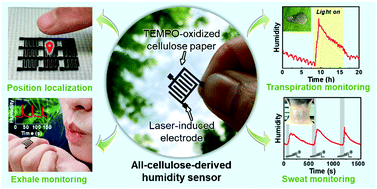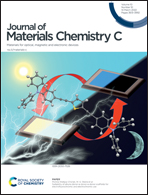All-cellulose-derived humidity sensor prepared via direct laser writing of conductive and moisture-stable electrodes on TEMPO-oxidized cellulose paper†
Abstract
Humidity sensing plays an important role in diverse applications in the fields of agriculture, healthcare, skincare, and environmental monitoring. With the advent of the “trillion sensor” society, there is a growing demand for humidity sensors that can be made from abundant and renewable resources. Cellulose, the most abundant and renewable bioresource on Earth, acts as a humidity-sensing material because of its hydrophilic nature. However, non-renewable noble metal electrodes are still indispensable because good electrical conductivity and moisture stability are necessary for reliably detecting electrical signals from cellulose-based humidity-sensing materials. Herein, we demonstrate the direct CO2-laser writing of electrodes onto TEMPO-oxidized cellulose paper to realize an all-cellulose-derived humidity sensor. The TEMPO-oxidized cellulose paper with sodium carboxylate groups provides a satisfactory humidity-sensing performance and is converted to conductive and moisture-stable electrodes directly via laser-induced carbonization. The resulting all-cellulose-derived humidity sensor demonstrates high sensitivity and linearity over a wide range of relative humidity (11–98%), thereby providing broad applicability. The sensor can be used for the positional localization of moist objects and for monitoring plant transpiration and human-body sweating. These results open the door for renewable and sustainable humidity sensors.



 Please wait while we load your content...
Please wait while we load your content...